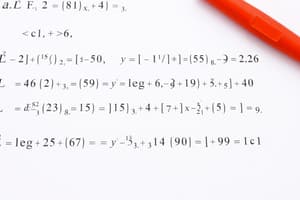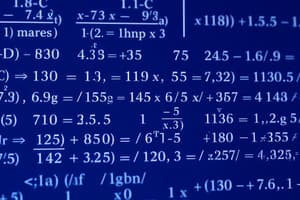Podcast
Questions and Answers
What is the base of a common logarithm?
What is the base of a common logarithm?
- 1
- 2
- 10 (correct)
- e
Which of the following expressions is equivalent to $log_{2} 8$?
Which of the following expressions is equivalent to $log_{2} 8$?
- 8
- 4
- 3 (correct)
- 2
What is the value of $log_{5} 1$?
What is the value of $log_{5} 1$?
- 5
- 1
- undefined
- 0 (correct)
What is the relationship between logarithms and exponentiation?
What is the relationship between logarithms and exponentiation?
What is the natural logarithm denoted by?
What is the natural logarithm denoted by?
Flashcards
Logarithm
Logarithm
A mathematical function that determines the exponent needed for a specific base to produce a given number.
Base of a Logarithm
Base of a Logarithm
The number that is raised to a power to obtain another number in logarithmic expressions.
Common Logarithm
Common Logarithm
A logarithm with base 10, often written as log(x) or log10(x).
Natural Logarithm
Natural Logarithm
Signup and view all the flashcards
Logarithmic Scale
Logarithmic Scale
Signup and view all the flashcards
Study Notes
Definition and Properties
- A logarithm is the exponent to which a base must be raised to produce a given number. Mathematically, if by = x, then logb(x) = y.
- The base 'b' is a positive real number not equal to 1.
- Common logarithms use base 10 (log10(x)). Natural logarithms use base e (loge(x)), which is also written as ln(x).
- Logarithms are the inverse functions of exponential functions. If f(x) = bx, then f-1(x) = logb(x).
Logarithm Rules
- Product rule: logb(xy) = logb(x) + logb(y)
- Quotient rule: logb(x/y) = logb(x) - logb(y)
- Power rule: logb(xy) = y * logb(x)
- Change of base formula: logb(x) = loga(x) / loga(b) (where 'a' is any base)
- logb(1) = 0
- logb(b) = 1
Common Logarithms (Base 10)
- The common logarithm, log(x), is the exponent to which 10 must be raised to equal x.
- Useful in scientific notation and problem solving in different scientific disciplines.
Natural Logarithms (Base e)
- The natural logarithm, ln(x), uses the irrational number e, approximately equal to 2.71828.
- ln(x) is the exponent to which e must be raised to equal x.
- Widely used in calculus and other areas of mathematics and science due to its relationship with exponential functions and derivatives.
Graphs
- Logarithmic graphs typically show a curve initially increasing rapidly and gradually flattening out as x grows larger.
- The graph always passes through the point (1,0) and approaches, but never touches, the y-axis.
Applications
- Widely used in various scientific fields including:
- Physics: Analyzing decay rates of radioactive materials, measuring sound intensity, and studying earthquakes.
- Biology: Modeling population growth and decay, and understanding chemical reactions.
- Chemistry: Calculating pH levels, determining concentration and measuring acidity.
- Engineering: Dealing with exponential growth, decay and other phenomena related to physics and engineering.
- The Richter scale, used to measure the magnitude of earthquakes, and decibels, used for measuring sound intensity, are also logarithmic scales.
Domains and Ranges
- The domain of a logarithmic function (logb(x)) is all positive real numbers (x > 0).
- The range of a logarithmic function (logb(x)) is all real numbers.
Calculating Logarithms
- Calculators and mathematical software are typically used to calculate logarithms.
Studying That Suits You
Use AI to generate personalized quizzes and flashcards to suit your learning preferences.




